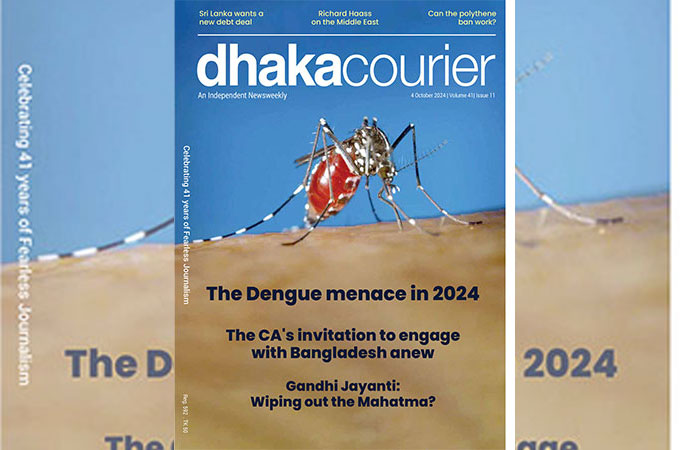Reportage

In this photo released by Colombia’s Armed Forces Press Office, soldiers and Indigenous men pose for a photo with the four children who were missing after surviving a deadly plane crash, in the Solano jungle, Caqueta state, Colombia, June 9,2023. (Colombia’s Armed Force Press Office via AP/UNB, File)
It is not surprising that the children whose plane crashed in the Amazon hid from the uniformed men rescuing them
"My life as a hero is nothing special," wrote Gabriel García Márquez in 'The Story of a Shipwrecked Sailor', his famous account of a sailor who spent ten days floating in the Caribbean after a naval accident caused by the Colombian Navy's negligence.
The story was based on a true event that was denied by the military authorities, who had blamed a non-existent storm for the disaster. It caused a great scandal when it was serialised in the Colombian newspaper El Espectador in 1955 - forcing the Nobel Prize-winning author into exile.
Almost 70 years later, 13-year-old Lesly, the eldest of four siblings from the Indigenous Muinane community, who survived 40 days lost in the Colombian jungle after their plane crashed, could easily claim that her life as a heroine is 'nothing special'.
Lesly's story is just another tale of extraordinary resilience, which connects with the history of more than 500 years of Indigenous survival in the Amazon, a violent and merciless environment where the first victims are often the children.
The children's survival has all the ingredients to become a successful Netflix series - but it also has dark undercurrents and illustrates the stark sociopolitical reality of Colombia, a country permeated by violence that continues unabated despite the efforts of successive governments, civil society and international cooperation.
In their long search to find crash survivors, who were known to be somewhere between the departments of Guaviare and Caquetá in the Amazonian region, the Colombian army came within ten metres of the four children. But the children apparently hid every time they heard helicopters and the voices of the military. They were afraid of them.
On 1 May, Lesly Mucutuy and her siblings - Soleiny (nine), Tien Noriel (four), and 11-month-old Cristin - set off in a single-engine plane with their mother, Magdalena Mucutuy, and Indigenous leader Hermán Mendoza Hernández, a family friend.
Magdalena, Hermán and the pilot were killed when the plane, an old US Cessna recycled for the precarious flights connecting communities in the Amazon, crashed. The family were on their way to meet Manuel Ranoque, Magdalena's husband and the biological father of the youngest two children.
Ranoque, who was governor of his Indigenous community in Puerto Sábalo, in Caquetá, claims that threats from the Carolina Ramírez Front, a dissident faction with roots in former guerrilla group FARC, had forced him to abandon his position as a social leader, his community and even his family, overnight earlier this year.
He says that after almost a month on the run, he found a way to communicate with his wife to tell her they would meet again in San José del Guaviare, in the Colombian Amazon, from where they would go to Villavicencio, in the Eastern Plains, or to Bogotá, the capital, to start a new life.
Ranoque said he thought he had escaped the alleged threats, but the media attention about the disappearance and subsequent discovery of his children put his life at risk again.
"The Carolina Ramirez Front is looking for me to kill me," he said in an interview. "I have threats, because I am a target for them." In another interview, picked up by The New York Times, Ranoque clarified: "I was very afraid that [the Front] would recruit children," adding that the country's armed groups "do not respect - they are capable of recruiting a child as young as two years old".
But then the group issued a statement denying such threats and the recruitment of children, and asked Ranoque to retract his claims in order "not to harm this attempt at a peace process that we have already begun with the national government". The children's maternal grandfather asked the same thing of Ranoque.
The mother's family also contradicted Ranoque's version and has since claimed custody of the children from the Colombian Institute of Family Welfare. They spoke of alleged sexual abuse and gender violence. Ranoque was forced to admit that he had assaulted Magdalena, both verbally and physically, although, he claimed, "physically not so much, because we had more verbal arguments".
The situation is confusing, and media overexposure raises questions that belie the initial heroic story and expose the many facets of Colombia's complex reality.
Absence of the state
Colombia is a country divided in two: a Colombia where the state governs and a Colombia where it does not. In the latter, the state's absence created power vacuums that were occupied by large landowners or illegal groups. These include armed guerrillas such as FARC (the Revolutionary Armed Forces of Colombia, the country's largest armed group) and the ELN (the National Liberation Army), as well as private armed militia groups hired by landowners, and organised crime gangs that are mostly linked to drug trafficking.
During the many decades of armed conflict, which began in 1964, FARC came to control 22% of the national territory - largely the country's poorest areas, which are mostly rural and close to the borders. These areas, which are also home to Colombia's main Indigenous ethnic groups, are remote, with poor communications and high rates of informal, low-paid employment. They have been colonised by illegal economies, such as coca cultivation or mining, which offered informal jobs for rural families.
The Colombian government's peace agreement with FARC, signed in 2016, attempted to resolve the conflict, but with little success due to political wrangling. The agreement was initially rejected in a referendum, then revised, but was greatly discredited due to a lack of interest in implementing it by the government of former president Iván Duque.
Today, large areas of the country remain outside state control. Although FARC withdrew from these regions following the peace agreement, the government's planned mitigation measures - such as land distribution, rural development and an alternative to illegal crops - did not come to fruition. Instead various illegal armed groups - some allegedly revolutionary, others criminal - rose to power and imposed their law by force as de facto authorities.
To hide is to survive
The Indigenous communities of the Colombian Amazon are among the groups that suffered the most from the more than five decades of armed conflict and from the consequences of FARC's sudden withdrawal from the region and the subsequent influx of other armed groups. Assassinations of social and environmental leaders, many of them Indigenous, have soared since 2016. In 2021, a member of Indigenous communities was killed every four days and Colombia had the second highest number of killings of environmental leaders in the world, after Mexico.
"State authorities responsible for the return of land often hand it over to large landowners and not to Indigenous groups," explained Monika Lauer Perez, a Latin America expert for a German aid organisation, in an interview with German public broadcaster DW in 2017. "You could say that the injustice continues, only without guns."
Little has changed in the past five years, although the election last year of left-wing president Gustavo Petro, with his commitment to "total peace", represents a new, albeit risky, effort to negotiate an end to violence with the different groups that continue to engage in it. Petro, who is in need of positive messages in the face of recent scandals, celebrated the discovery of the four children alive in the jungle and announced a six-month truce with the ELN, the country's main active guerrilla group, two weeks ago.
Against this backdrop of violence - and the alleged domestic violence the missing children may have witnessed at home, which is unfortunately common among Indigenous communities - it is not surprising that they tried to stay hidden and survive on cassava flour and fruit rather than surrender to unknown uniformed men who may have wanted to kill or recruit them.
In a way, they did as many of their ancestors did for centuries when their territories were colonised and their villages destroyed: resist and hide deep in the forest. After all, the forest is their natural habitat. They are part of its ecosystem and know how to survive off of it. The 'Chronicle of Four Children Lost in the Jungle' is like something the great García Márquez might have written, a miraculous tale of Indigenous survival wrapped in the tragic magical realism that pervades the country's violent history.
From openDemocracy

























Leave a Comment
Recent Posts
FIFA President to Join Youth F ...
FIFA President Gianni Infantino has said he will join the youth festiv ...
Chief Adviser Yunus engages wi ...
Chief Adviser Prof Muhammad Yunus on Tuesday had brief interactions se ...
Chinese investors interested in Bangladesh’s power, ..
Dr Yunus expands Council of Advisers with 3 new face ..
Bangladesh receives $655 million in remittances in 9 ..
COP29: Chief Adviser Yunus scheduled to leave for Az ..